The Harvest Strategy Standard
The Harvest Strategy Standard for New Zealand Fisheries guides the management of our fish stocks. It specifies four measures that are used to evaluate the status of New Zealands fish stocks and fisheries, with management priority being on the first three of these:
- the soft limit a biomass level below which a stock is deemed to be overfished or depleted and needs to be actively rebuilt;
- the hard limit a biomass level below which a stock is deemed to be collapsed where fishery closures should be considered in order to rebuild a stock at the fastest possible rate;
- the overfishing threshold a rate of extraction that, if exceeded, will lead to the stock biomass declining below management targets and/or limits; and
- the management target usually a biomass level,1 but sometimes a fishing mortality rate,2 that stocks are expected to fluctuate around, with at least a 50% probability of achieving the target.
The figure below shows the relationship between the management target and the soft and hard limits for a stock that is fished perfectly at a constant rate that tracks fluctuations in stock size. Fish stocks are expected to fluctuate around their targets with at least a 50% probability of achieving the target. This means that for well-managed fisheries at any given point in time approximately 50% of stocks should be above their management targets and 50% below.
Some organisations and media outlets repeatedly misinterpret the role of the management target, either deliberately or through lack of care. Simply because a stock is below the management target does NOT mean it is overfished or in danger, as is repeatedly reported by the media and some environmental organisations. Stocks that are below biomass limits (the soft or the hard limit), or where overfishing is occurring are in greater need of management intervention and therefore these stocks are more relevant for reporting on management issues.
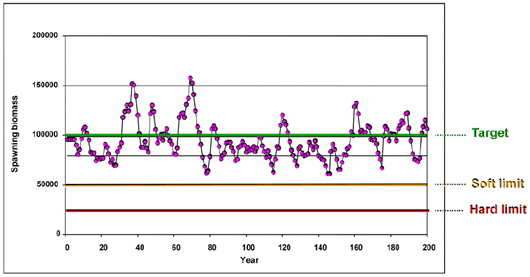
Stock Assessments
Each year, the Ministry for Primary Industries convenes Fisheries Assessment Working Groups that combine the results of scientific research with catch reports from commercial fisheries and data from the observer programme to produce assessments of the status of New Zealands fish stocks. This information is summarised in two annual Fisheries Assessment Plenary Reports.
There are currently 636 stocks in the Quota Management System (QMS). Of these, 288 stocks are considered to be nominal stocks (fish stocks for which a significant commercial or non-commercial potential has not been demonstrated), leaving 348 stocks that are included in this evaluation.
The number of stocks of known status relative to the four harvest strategy standard measures varies because, for example, while it may not be possible to determine whether a stock is somewhat above or below its management target, it may be clear that it is above the hard limit. In 2012 stocks of known status relative to the management target accounted for 63.4% of the total landings by weight and value3 representing most of the main commercial fish species.
2012 Evaluations
New results for 2012 and recent trends in the four measures are summarised below. Evaluations of the first three of the measures have been undertaken since 2009, while the last has been calculated since 2008.
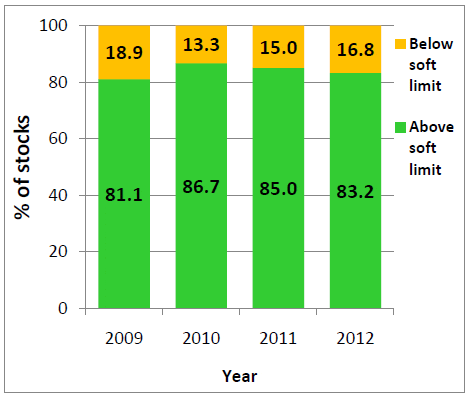
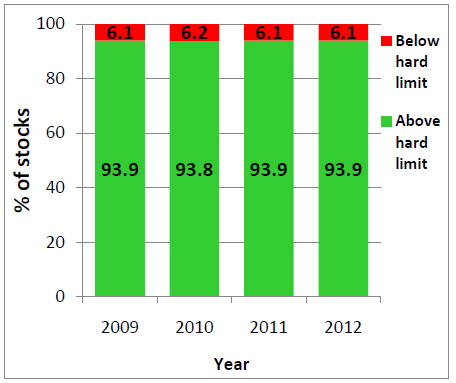
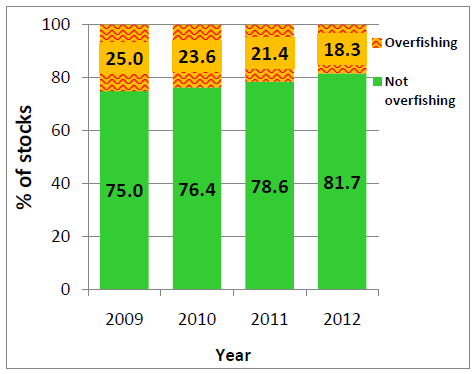
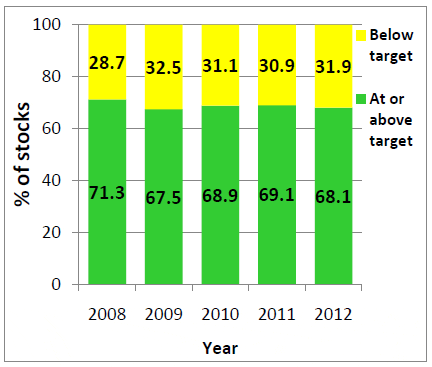
Fisheries Management Responses
The main fisheries management mechanism used to take advantage of utilisation opportunities for high performing fish stocks, or to reduce sustainability risks for fish stocks that are not meeting their performance metrics, is to modify the Total Allowable Catch (TAC) or Total Allowable Commercial Catch (TACC) appropriately.
Highlights
- As a consequence of substantial reductions in hoki quotas over the period 2002-07, both stocks of hoki (eastern and western) have continued to increase in size for the last six consecutive years, and both are now well within their management target range. As a result, the hoki quota was progressively increased from 90,000 metric tonnes to 130,000 metric tonnes over the period 2009-2011.
- In 2011 a new and substantial aggregation of orange roughy was surveyed on the Chatham Rise and this has led to a favourable revision of the status of this orange roughy stock.
- The Campbell Island Rise stock of southern blue whiting was estimated to be well above its management target and is currently at an historic high.
- Gurnard around the east and south coasts of the South Island was assessed to be very likely to be above its management target and on the west coast of the South Island the trawl survey estimate for 2011 was the highest recorded over the period 1992-2011.
- The trawl survey estimate for John dory off the west coast of the South Island was also the highest recorded over the period 1992-2011.
- Elephantfish around the east coast of the South Island appear to have fully rebuilt from the low levels experienced in the late 1980s and elephantfish around the south coast of the South Island have been continually increasing since the mid-1990s.
Management of Stocks Below Biomass Limits
At the time of their most recent assessment, 21 (of 125) stocks were considered to be below the soft limit (and therefore overfished):
- southern bluefin tuna (a highly migratory species seasonally present in New Zealand waters);
- three stocks of black cardinalfish;
- five stocks of bluenose;
- six stocks or sub-stocks of orange roughy;
- two stocks or sub-stocks of scallops; and
- one stock or sub-stock each of paua, rock lobster, snapper and rig.
Ten of these 21 stocks were also considered to be below the hard limit (collapsed). Overfishing was documented for 19 stocks. (For further details see the Status of Stocks page at http://fs.fish.govt.nz/Page.aspx?pk=16&tk=478).
In all cases where fisheries are below the soft or hard limit, corrective management action has been, or is being, put in place to rebuild the stocks. For example, fisheries on three previously-collapsed orange roughy stocks were closed (they effectively have a TACC or voluntary catch limit of zero) to maximise the rate of rebuilding. Two of these have since been re-opened. In 2010, the industry Deepwater Group voluntarily agreed not to fish for orange roughy on the northwest Chatham Rise. The Tasman Bay scallop fishery has been voluntarily closed by the fishing industry to commercial fishing since 2006. Bluenose stocks were identified as being in need of rebuilding in May 2008, and TACCs have subsequently been reduced with further reductions introduced in 2012 to ensure the stocks rebuild to target levels. The Commission for the Conservation of Southern Bluefin Tuna (of which New Zealand is a member) has adopted a management procedure tuned to rebuild the stock to interim and long-term target levels.
These changes demonstrate the responsiveness of New Zealands fisheries management system to the intrinsic fluctuating nature of wild fish stocks and our contributions to the management of international fish stocks.
January 2013


